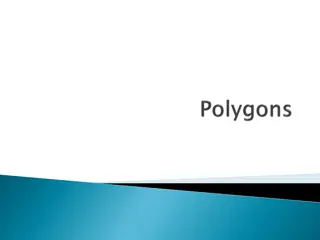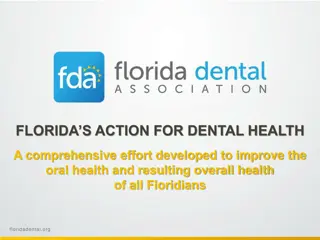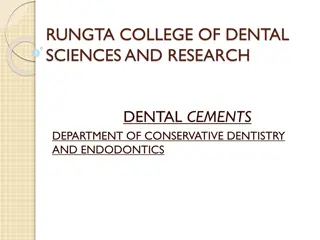Understanding Dental Cements and Temporary Filling Materials
Dental cements are essential in dentistry, acting as barriers against various stimuli and irritants. They can be classified based on different compounds and have specific applications such as root canal sealers and orthodontic bonding. Zinc phosphate cement is a common material used for lining, while luting materials have specific properties for effective use. Ideal cement materials should protect the pulp, be compatible with fillings, and have sufficient strength. Explore the classifications, properties, and uses of these vital dental materials.
Download Presentation

Please find below an Image/Link to download the presentation.
The content on the website is provided AS IS for your information and personal use only. It may not be sold, licensed, or shared on other websites without obtaining consent from the author. Download presentation by click this link. If you encounter any issues during the download, it is possible that the publisher has removed the file from their server.
E N D
Presentation Transcript
Dental cement and temporary filling materials Dental cements materials: are materials of low strength but they are used extensively in dentistry .They dissolve in oral fluids ,also called cement base or lining, used underneath the filling material to act as a barrier against thermal, electrical and chemical stimuli also against irritant filling. Luting cements: cements base used for cementation of crown and bridge restorations.
Requirements for ideal cement materials: 1-Protect the pulp from chemical irritants of the filling like acrylic monomers in some of resin based filling material. 2-Form a protective barrier against thermal stimuli especially under metallic restoration and acrylic based filling. 3-protect the pulp from electrical current created when the amalgam restoration placed in contact with gold restoration. 4-It should have sufficient working and setting time. 5-It should be compatible with the filling material. 6-Should not irritant to the pulp. 7-Should not absorbed by oral fluid especially for the luting material. 8-Should has enough strength to withstand the force applied.
Special Applications 1- Root canal sealer. 2- Gingival tissue pack. 3- Surgical dressing. 4- Cementation of orthodontic bands. 5- Orthodontic bonding.
Classification 1-Cements based on phosphoric acid: a-Zinc phosphate cement. b-Silico phosphate cement. c-Copper cement 2-Cements based on organo metallic chelate compounds: a-Zinc oxide\ eugenol cement. b-Ortho-ethoxybenzioc acid(EBA) c-Calcium hydroxide cement. 3-Cement based on polyalkenioc acid: a-Zinc polycarboxylate cement. b-Glass ionomer cement. 4-polymeric cement.
Zinc phosphate cement Powder and liquid, two paste Powder :zinc oxide (reactive component) and other oxides like magnesium oxide. Liquid :aqueous solution of phosphopric acid buffered by zinc oxide and aluminum oxide. Uses: 1-lining materials
2-Luting materials 3- Sometimes used as a temporary filling material. Properties: 1-Have a sufficient working time. 2-proper film thickness when used as a luting aagent , depends on particle size and P\L ratio. 3- Ultimate compressive strength for luting agent reach about 80 MPa for lining material 140 MPa ,so it can with stand the forces applied during amalgam condensation,5 minuts should be left before placement of the amalgam filling. 4-Low solubility in water. 5-High initial acidity especially when freshly placed this depend on the P\L ratio, so in deep cavity a sub liner should be used. 6-Good thermal insulator. 7-The material is opaque due to high amount of un reacted zinc oxide, so it should not be used under porcelain teeth.
Manipulation: The P\L ratio is according manufacturer instruction .Usually for cavity lining putty like consistency P\L ratio (3.5\1) for the luting more fluid mix more fluid mix required to have adequate flow. Low P\L lead to high acidity and weak mix and irritation of the pulp. High P\L lead to thick mix and decrease setting time and insufficient working time. Mixing is done on cold slab, because the reactin is exothermic, the powder is best incorporated in to the liquid by small increments until the desired consistency is reached. a-delay the set slightly and create more working.
b-allow sufficient powder to be incorporated into the liquid lead to higher strength achieved in the final set material. Silicophosphate cement: Liquid: phosphoric acid Powder :mixture of zinc oxide and aluminosilicate glass. - the set material is more soluble than zinc phosphate cement , but more translucent cement so can be used under porcelain restoration. -it contains sufficient amount of fluoride ion has a significant anticariogenic influence on the surrounding tooth substance. Uses : luting cement and temporary filling.
Copper cement: Powder: is amixture of zinc oxide and copper oxide. Liquid :phosphoric acid. -has a bacteriocidal effect produced by the presence of copper has black appearance. used in deciduous teeth. - Zinc oxide eugenol cement. Powder :zinc oxide and zinc acetate(accelerator) Liquid :eugenol, olive oil (control viscosity) Uses: 1-temporary filling. 2-Retention of temporary crowns. 3-cement base especially resin reinforced zinc oxide eugenol. 4-Root canal paste but has certain additives.
Properties: 1- compressive strength 20 MPa so not used under amalgam, the reinforced material has a higher strength 40MPa so can be used under amalgam. 2-can be used in deep cavity without subliner (not irritant to the pulp). 3-higher solubility so not used as a luting agent. 4- free eugenol has an effect on resin based filling material ,interfere with polymerization and setting time , cause discoloration so not used as a lining with these types of filling. 5- effective thermal barrier.
Calcium hydroxide Ca (OH)2 Either suspension of ca(OH)2 in water or mostly as 2 pastes. One paste contains ca(OH)2 and accelerator(zinc stereate) Other contains glycol salicylate with inert fillers ,pigments and radiopacifiers. Indication: as a subliner material and pulp capping.
Properties: 1-set within few seconds ,setting time affected by moisture. the set of light activated material is more under control by operator 2-Relatively weak compressive strength 29 MPa. 3-High solubility , not used as luting agent. 4-Sufficient biocompatibility when placed adjacent to the pulp and can destroy any remaining bacteria, also it is able to initiate formation of secondary dentine layer at the base of cavity so used as pulp capping. 5-It can be used under resin based filling material : composite filling. 6-Not used as luting agent
Polycarboxylate cement: Powder: Zinc oxides and aluminum oxide. Liquid:Aqueous solution of polyacrylic acid 40%. Properties: 1-Ultimate compressive strength 80MPa which is sufficient to with stand amalgam condensation. 2- acidic but less irritant than zinc phosphate cement. a-polyacrylic acid is weaker acid than phosphoric acid. b- polyacrylic acid has a large molecules and lack mobility to penetrate to dentinal tubules .but not used in deep cavities without subliner. 3-higher solubility than zinc phosphate and glass ionomer but used widely as luting agent. 4-Form an adhesive bond with enamel and dentine, weak bond with gold and strong bond with stainless steel, so used for bonding ortho bands. 5-Set material is opaque and this may detract from the appearance of porcelain crown especially if cement lute margin is visible.
For the powder and water product :polyacrylic acid is incorporated in powder. Uses: 1-cement base. 2-luting agent for crown and bridge. 3-bonding of ortho bands. 4-restoration of deciduous teeth. P\L ratio 1.3:1 P\W ratio3.3:1 Mixing on paper pad with stiff spatula, mixing time is 30-60 seconds, the cement should be used immediately because the working time is2 minutes .Working time can be increased when mixing is done on cold slab.
GIC Properties: 1- compressive strength range from 60MPa cement material and 220 MPa for filling material. 2-Adhere well to tooth substance(the free carboxyl group bonds to the hydroxyapetite of enamel and dentine giving initial adhesion. 3- lower solubility than ZPC 4- Translucent due to the presence of unreacted glass. 5-high acidity at freshly mix. 6-Has sustained fluoride relrease.
Temporary filling materials Indications: 1-During treatment of root canal filling. 2- Inlay and only preparation. TF should be placed after preparation until the final restoration is placed. 3-After pulp capping in case of traumatic exposure, to give time for pulp healing process and production of dentin. 4-In pedodontic treatment.
Requirements: 1-Should be easily removed from the cavity. 2- Should have sedative effect to the tooth. 3- Reasonable strength and abrasive resistance. 4- Radiopaque. 5-Reasonable setting time and has flow after setting.
Types of TF: 1-Zinc oxide eugenol ZOE 2-Zinc phosphate (ZP) 3-Zinc silico phosphate(ZSP) 4-Gutta percha(G.P)
Zinc oxide eugenol According to ADA specification. There are 4 types of ZOE: Type 1:temporary cementation Type 2:permanent cementation of the restoration. Type 3:temporary filling. Type 4:cavity liner (base). It s the material of choice as temporary filling. supplied as : Dental cement materials Powder :zinc oxide , zinc acetate. Liquid: olive oil, eugenol.(mixing according to manipulation instructions).or as 2 pastes or 1 paste.
Properties: 1-It has sedative effect on the teeth , reasonable sealing of the cavity ,but it has low strength, low abrasive resistance, low flow after setting.placement of ZOE should not be more than few days, maximum few weeks. 2-The strength and abrasive resistance could be improved by adding 20-40 wt% of fine polymer particles and treating the surface of zinc oxide particles with carboxylic acid(reinforced ZOE type). 3-Sufficient powder should be added to the liquid to achieve putty consistency.
Zinc phosphate cement Powder and liquid Properties: 1-Has higher strength and abrasive resistance than ZOE, has a relatively low solubility in oral fluids .but still has low abrasive resistance in area subjected to high load of mastication. 2-Higher powder \liquid is required for low acidity and high strength. 3-Reinforced Z phosphate is more durable and could be used when longer time for TF is required. Zinc silico
Zinc silico phosphate Powder: zinc oxide powder and silicate glass. Liquid : phosphoric acid. Used as TF because of fluoride presence in its composition. Properties: 1-Has superior strength and it is more translucent than Z phosphate. 2-Not promote healing of the pulp. 3-Used when longer time for T filling is required.
Gutta percha Composition: Natural gutta percha, Zinc oxide,wax or resin and metal salts to give radiopacity. It is supplied by softening the G.P. on the flame and put it inside the cavity. Disadvantages: 1-Lack the ability to seal cavity. 2-Heat lead to pain to the patient. 3-Low strength























